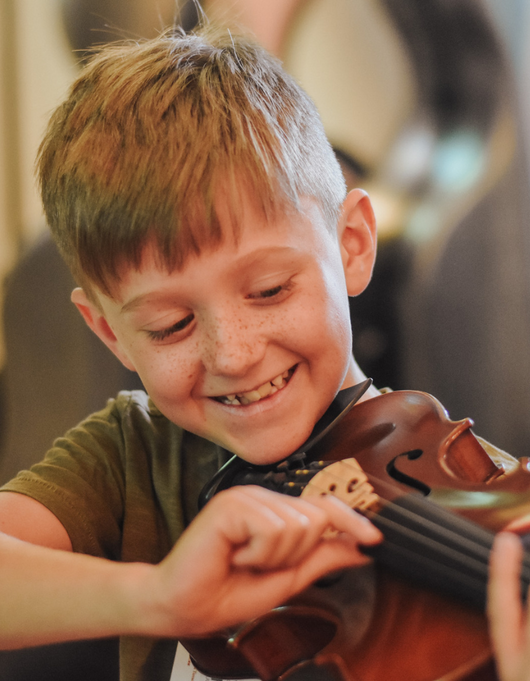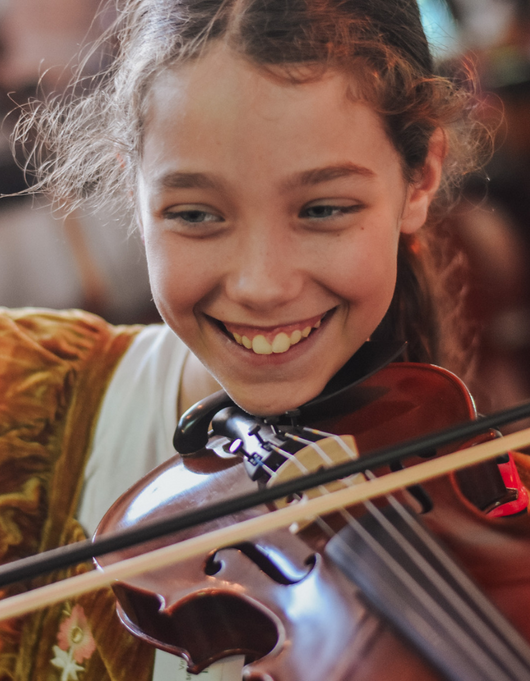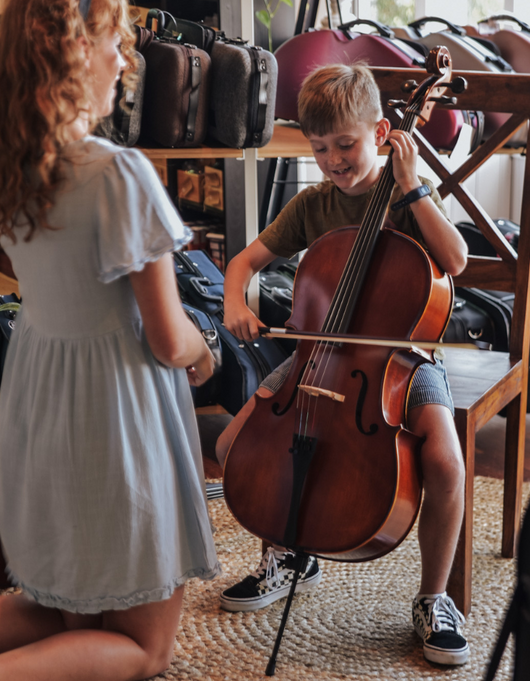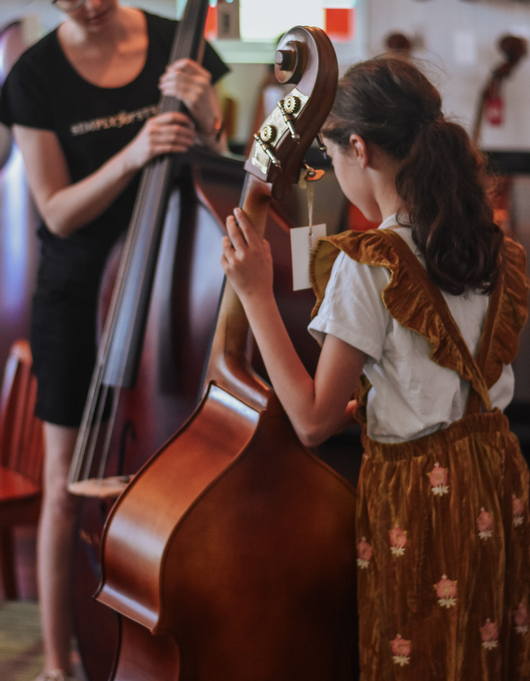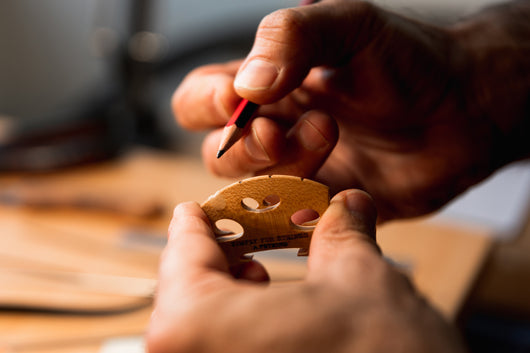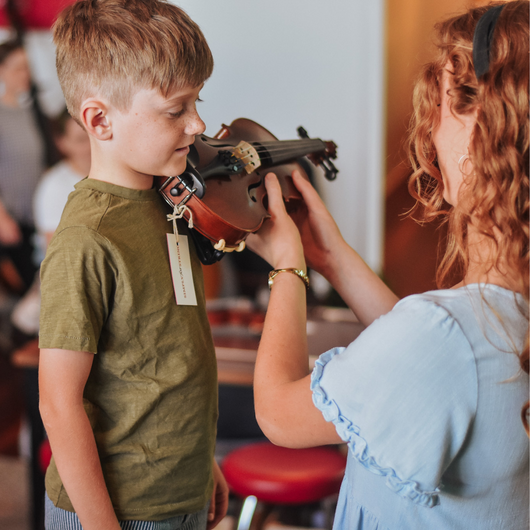There are so many things to consider when you’re starting a new musical instrument, whether it’s the violin or the saxophone! It can feel a little overwhelming - what age is best to start, what accessories do I need, will I even enjoy this? We’re here to make the start of your musical journey a little easier - we know exactly how you’re feeling and it’s our pleasure to share our advice with you. This guide is perfect for parents or even adult learners themselves.
What’s the best age to start as a child?
A child should start learning when they are ready.
What do we mean by that? You can start the learning process informally from a very early age - eg 3 years old, wait until 5 or 7 if you prefer.
The guide we recommend looking for is interest. If the child is eager to learn, and is showing an inquisitiveness, there is more likely to be immediate progress. Some children show a “want” regarding the violin but when we try to engage them they show no focus. Perhaps they simply aren’t ready! Some teachers in our team have experienced this over the years with their students, and they have come back a couple of years later ready to learn.
Don’t force kids before they are ready - if they start in their own time, they are more likely to enjoy the journey, hence will show better progress as well.
Thoughts from private teacher and former Education Queensland teacher, Michael:
“The Education Department in Queensland has set the standard at primary school Grade 3 for stringed instruments and Grade 4 for wind and brass. This works very well for us in QLD, because generally by Grade 3 we find most children have better attention and retention. This also works well for group lessons with an ensemble focus. Many independent schools opt to have a strings immersion programme in Grade 1 or 2, and it works extremely well for them. When I taught in independent schools most of my beginners were in Grade 1, but there the groups were no bigger than two students in a lesson. As a private music teacher I find children more able to apply themselves from Grade 1 or 2 in an individual session. If your child is showing an enquiring mind earlier, then great!”
Get your kids into violin lessons if that’s what they want, but be aware that pre-Grade 1 children may not be able to focus well enough yet, and don’t turn them off music by pushing them too hard, too soon. The best thing you can do to get the ball rolling is expose your small child to music and see where it takes them. There are hundreds of music appreciation groups for small children around the country that will give your child an excellent start to their musical journey before progressing to a violin.
Learning as an adult
The most frequently asked question from adults at Simply for Strings is this - have I left it too late? And our answer? It’s never too late to start.
Many adults take up a musical instrument. Often it’s when their children are a bit older and you have time to do something for yourself, or you’re an adult who would like to re-start. If it’s something you’re passionate about and can invest time in most days (even if it’s just 15 minutes) why not?
We are often asked by older people if they have left it too late. It’s never too late to start, and by all accounts is very good for our ageing brains. Those of us who teach have had beginners of all ages: you can learn more about the benefits of learning a stringed instrument.
What violin should I buy?
There are thousands of options on the market, so it’s important that you shop with a reputable violin store or maker. Here at Simply for Strings, we pride ourselves on setting up each and every violin for success. Our professional setup ensures that it is easy to play and sounds great. Your first violin doesn’t have to be a Stradivari - but it does need to be professionally set up to ensure you're starting your musical journey on the right foot.
Renting is also a great option if you’re not sure about whether you or your child will enjoy the violin - you might find yourself playing viola or cello instead! Read our guide to renting versus buying.
If you’re an adult learner, you may only want to buy an instrument once, and buy well. If your budget allows for this, it is a great place for starting and continuing to develop your musical skills. For this, we recommend browsing our intermediate and advanced level violins. This level will mean you have an excellent violin that helps with your development, as it produces a lovely, clear tone and is very easy to work with.
Read our violin price guide - and what to expect in every range - here.
If you want to buy, but don’t want to splash out just yet, we recommend purchasing a good quality beginner instrument and upgrading the strings. Many beginner instruments will be fitted with basic steel strings from the manufacturers. Our advice is to upgrade the strings from the start: this will make learning easier, as the sound you produce will immediately be more enjoyable and rewarding.

What violin size do I need?
In selecting a violin, we need to check which size you need.
Children require the correct size or their development can be impacted. Usually I would expect a child to start on a ¼ size for two years (if they begin at 6 yrs-old), then ½ for another two years, ¾ for two, then somewhere between 11 and 13 yo they would move to full size (4/4).
Adults play 4/4 violins, unless their fingers are much smaller. Occasionally an adult might need to play a ⅞ or even ¾ violin, but this is fairly uncommon.
View our size guide to measure yourself or your child at home, or drop in to Simply for Strings to be assisted by one of our violin-playing staff.
Getting lessons as an adult
There are lots of resources available when it comes to actually starting to play your new violin. There are plenty of resources on YouTube and other platforms that can help you to get started by yourself if necessary. Some of the beginner method books on the market also link in with Smart music, an interactive practice software that helps you learn and keeps you on track.
However, a very important part of learning a stringed instrument is technique, including posture. Online resources can tell you if you’re in tune and in time, but at some point soon you will need expert eyes to watch you and give this important advice. Incorrect posture or technique can cause ongoing difficulties with intonation, but they can also create physical injury over time, causing both your body and your bank account considerable pain. We do recommend visiting a violin teacher as you start off, to ensure your posture is correct and not causing you any pain.
Learn more about what to expect when you re-start your musical journey as an adult.
If you’re looking for lessons for your child, there are local music schools in most suburbs. The majority of these will have string teachers who specialise in playing and teaching the violin. If you’re local to Simply for Strings, and don’t know where to start, pop in and let us help - we have a database of teachers whom we know and can recommend. You may find lessons at a local music school, your teacher’s home studio, at your home or online lessons.
Learning how to read music
If you are an adult beginner, you may know how to read a little bit of music already. If your child is about to start music lessons, they may not know at all - and that’s completely okay!
If your child is learning at school, the teacher will be following a carefully planned roster of work that allows the students to learn without “gaps”.
Some of the main beginner tutor books introduce you systematically to the theory aspect of music, teaching note reading from the very start, then reinforcing each new note or concept in the next few pieces you will learn. If you are hoping to learn as much as possible on your own, these books will help best.
It may also be helpful to start working through an introductory theory book. Here are some theory books designed for beginning violin:
- All for Strings Theory Violin Book 1
- I Can Read Music Violin Volume 1
- Basic Music Theory and History for Strings Book 1 Violin
If using a method book by yourself, avoid the temptation to look for the songs you like. Method books are designed for practical, sequential learning. Work through the book systematically, reading everything, playing everything, doing every activity the book asks of you. This may seem slower and “boring” but will ensure you learn everything you need to set yourself up for success. As stated earlier, some books have online practice resources. Use them: they actually help!
Likewise with your teacher: if you feel they are teaching you too slowly, holding you back, or not teaching you enough fun material further through the book, please have patience! They are doing this for a good reason. We have to give you solid foundations. Otherwise you will be making all sorts of mistakes that you're not aware of, and when you play with others it can become a frustration for you and them.
Shop beginner method books for violin.
Below are some of our top sheet music recommendations - browse our website for our vast collection, or pop into the Old Church to browse in person.
- Suzuki Violin School Volume 1 with CD
- First 50 Songs You Should Play on the Violin
- Simple Songs for Violin with Online Accompaniments
Maintaining your violin as a beginner
Just like your car, your violin needs regular servicing to ensure it runs smoothly. We recommend getting into good cleaning habits from the get-go. Here are some quick tips:
- Clean your violin every time you play. Wipe the strings, fingerboard and body clean of fingerprints and oil from your skin, and to restrict the chance of rosin dust building up on either the strings or the body.
- Your bow should always be stored without tension. When winding it up to play, usually the best tension is when just the tip of your index finger can fit between stick and hair at the middle of the curve. Another way to tell if it has a good tension is to draw the bow across your strings at about mezzoforte (just moderately loud). If the stick is dragging on the strings, instead of just the hair touching them, then it needs to be tightened a little more. You never want the stick to be fully straightened, or curved outwards.
- Sometimes the bow hair can stretch due to weather, and if it stretches too far you may need to replace the bow (or rehair it if it is of a price value that justifies rehairing).
- In times of weather change, atmospheric pressure variation, extra humidity or extreme dryness, your violin and bow will change and perform differently. Always try to keep your violin and bow in a safe place to avoid unnecessary temperature changes.
Read our ultimate care and maintenance guide.
What violin accessories do I need to buy?
Some great accessories to help you get started are:
- Shoulder rest (absolutely essential)
- Metronome
- Tuner
- Rosin (essential)
- Music stand (essential)
- Violin humidifier, a must in dry weather
- A violin stand can be very helpful: because when it’s left out we more frequently pick it up! However, in times of changing whether you should store the violin in its case as a buffer against sudden changes.
Read our guide to what violin accessories are actually worth buying.
The Tailpiece (Some Extra Tips)
- When you practise, the best policy is to work through each item (scale, exercise, song, piece) until you make no mistakes. Then play it three (3) times in a row without obvious error. If you make a mistake on the third time you’re back to 0.
- Practice does not make perfect. Practice makes permanent, and that’s why we do it. We want to train best habits in and weed errors out. Only perfect practice makes perfect: otherwise we are simply training to ensure we keep making the same mistake.
- When playing your violin, you need your feet slightly apart, level with your shoulders; your torso (upper body) needs to be straight, upright and facing forward. Don’t bend to the violin: make it fit you.
- Keep your back straight and your core engaged. Many violinists develop back pain due to weak posture.
- Shoulders should be relaxed, not raised in tension.
- If possible, visit our store to make sure your shoulder rest and chinrest are the best ones for your personal best posture.
Read our starters guide to violin posture for more great posture advice.
We hope this guide has answered your questions. Our friendly team is always ready to help you start your musical journey. Give us a ring on 07 3368 3666, or visit our beautiful Red Hill store.



